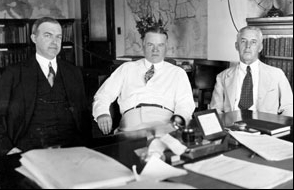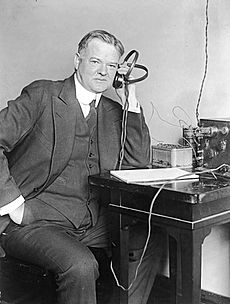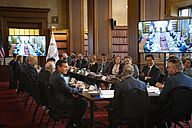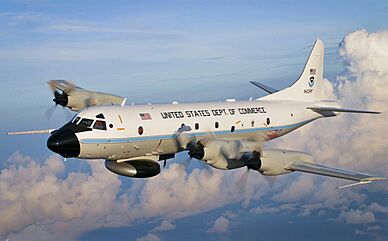United States Department of Commerce facts for kids

Seal of the U.S. Department of Commerce
|
|

Flag of the U.S. Department of Commerce
|
|
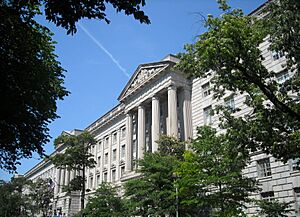 The Herbert C. Hoover Building, the headquarters of the U.S. Department of Commerce |
|
| Agency overview | |
|---|---|
| Formed | February 14, 1903 |
| Preceding agency | |
| Jurisdiction | U.S. federal government |
| Headquarters | Herbert C. Hoover Building 1401 Constitution Avenue NW, Washington, D.C., U.S. 38°53′39″N 77°0′58″W / 38.89417°N 77.01611°W |
| Employees | 48,391 (2024) |
| Agency executives |
|
The United States Department of Commerce (often called DOC) is a part of the U.S. federal government. It helps businesses and the government make smart choices by collecting important information. It also sets standards for industries, helps the economy grow, encourages foreign companies to invest in the U.S., and protects the country's economic safety.
The Department of Commerce is one of a few government groups that can send people to work in the United States Foreign Service overseas. Its NOAA Corps is also one of the eight uniformed services of the United States. When a big disaster happens, the department helps coordinate how the economy recovers. Since 2023, it has also been in charge of making sure artificial intelligence (AI) is developed safely.
The department is led by the Secretary of Commerce. This person is a member of the president's Cabinet and is tenth in line to become president if needed. The main office is in the Herbert C. Hoover Building in Washington, D.C..
Contents
What the Department of Commerce Does
The Department of Commerce updated its main goal in its plan for 2022 to 2026.
The Department of Commerce’s mission is to create the conditions for economic growth and opportunity for all communities.
This means the department wants to help everyone have a chance to succeed and for the economy to get stronger.
Its main parts do many different jobs:
- NOAA (National Oceanic and Atmospheric Administration) helps with weather forecasts, watching the climate, and managing fishing.
- The International Trade Administration helps U.S. companies sell their products to other countries and encourages foreign companies to invest in the U.S.
- The Bureau of the Census counts people every ten years and collects other important facts about the economy.
- The Bureau of Industry and Security controls the export of sensitive technologies.
- The U.S. Patent and Trademark Office registers new inventions (patents), brand names (trademarks), and creative works (copyrights).
- The National Institute of Standards and Technology makes sure the U.S. system of weights and measures is correct.
- The FirstNet Authority manages a special broadband network for emergency responders.
- The Economic Development Administration helps coordinate economic recovery after big disasters.
How the Department Started
Early Years
The Department of Commerce began on February 14, 1903. It was first called the United States Department of Commerce and Labor. Later, on March 4, 1913, it was renamed the Department of Commerce. This happened because the parts of the department that dealt with labor issues were moved to a new group, the Department of Labor.
Over the years, many different agencies have moved in and out of the Commerce Department. For example, the United States Patent and Trademark Office joined in 1925. The Weather Bureau, which is now the National Weather Service, moved to the department in 1940. Also, the National Oceanic and Atmospheric Administration (NOAA) was created and joined the department in 1970.
Computer Security Issue in 2020
In 2020, the Department of Commerce had a computer security problem. Its systems were attacked, and some data was accessed. Experts believe a foreign government was likely behind this attack.
Herbert Hoover as Secretary of Commerce
Herbert Hoover became the Secretary of Commerce in 1921. He was appointed by President Warren G. Harding. Hoover was a very active secretary, more than any before him, and he served until 1928.
When he took the job, the Secretary of Commerce position was not considered very important. But Hoover, who was a businessman, saw a chance to make it a key part of the government. He believed the government could help the country grow and be stable. He wanted to make things more efficient, increase production, and protect natural resources.
Hoover worked to bring together different parts of the government to improve the economy. He created many new offices and committees. Some people even joked that he was the "Secretary of Commerce and Under-Secretary of all other departments" because he took on so many responsibilities.
Radio and Travel Improvements
When Hoover started, very few families had radios. By the time he became president in 1929, millions of homes had them. Hoover's department helped set the rules for this new industry. He helped pass the Radio Act of 1927, which allowed the government to manage radio stations.
Hoover also played a big role in the early days of air travel. He encouraged the building of emergency landing fields and made sure runways had lights and radio signals. He also helped the government start inspecting planes and licensing pilots. This set the stage for how air travel is regulated today.
He also organized national meetings about street traffic safety. His goal was to reduce traffic accidents. These meetings led to rules for cars, driving, and city traffic. Many of these ideas were used by states and cities to make roads safer.
Other Things Hoover Did
Hoover wanted to help businesses make smart choices. He made the Commerce Department a place where businesses could get lots of information. He hired experts to write reports on different parts of the economy. He also encouraged companies to make products more standard, like car tires and baby bottle nipples, to reduce waste.
He also helped promote international trade by opening offices in other countries to advise U.S. businesses. He was especially keen on promoting Hollywood movies overseas.
Hoover also started the "Own Your Own Home" campaign to encourage people to buy houses. He worked with banks to create new types of home loans, which helped a lot of people buy homes.
Helping with Foreign Trade
The Department of Commerce has always worked to help U.S. businesses trade with other countries. It has staff in U.S. embassies around the world. The International Trade Administration helps American companies understand foreign rules and find markets. The Office of Export Enforcement controls what technologies can be exported, especially sensitive ones like nuclear or advanced electronics.
The department also works to stop other countries from selling products in the U.S. at unfairly low prices or giving unfair help to their own businesses. This work can sometimes cause disagreements with other nations.
How the Department is Organized
Main Buildings
The Department of Commerce's main office is the Herbert Hoover Building in Washington, D.C. It moved there in 1932 after the building was finished. Before that, it was in other buildings in the city.
Who Leads the Department
The Secretary of Commerce is the main leader of the department. This person is part of the President's Cabinet. If the Secretary cannot do their job, other officials are ready to step in temporarily. These include the Deputy Secretary of Commerce and other Under Secretaries who lead different areas of the department.
Main Operating Groups
The Department of Commerce has many different groups that do its work. Here are some of the main ones:
| Program | |
|---|---|
| Secretary of Commerce (Deputy Secretary of Commerce) |
Economic Development Administration |
| National Telecommunications and Information Administration | |
| Office of Business Liaison | |
| Office of the Chief Financial Officer and Assistant Secretary for Administration | |
| Office of the Chief Information Officer | |
| Office of Executive Secretariat | |
| Office of the General Counsel | |
| Office of Inspector General | |
| Office of Legislative and Intergovernmental Affairs | |
| Office of Policy and Strategic Planning | |
| Office of Public Affairs | |
| Office of Security | |
| Office of Space Commerce | |
| Office of White House Liaison | |
| Under Secretary of Commerce for Economic Affairs | Bureau of the Census |
| Bureau of Economic Analysis | |
| Under Secretary of Commerce for Industry and Security | Bureau of Industry and Security |
| Office of Export Enforcement | |
| Under Secretary of Commerce for Intellectual Property | Patent and Trademark Office |
| Under Secretary of Commerce for International Trade | International Trade Administration |
| United States Commercial Service | |
| Under Secretary of Commerce for Oceans and Atmosphere | National Marine Fisheries Service |
| National Oceanic and Atmospheric Administration | |
| National Oceanic and Atmospheric Administration Commissioned Corps | |
| National Ocean Service | |
| National Weather Service | |
| Office of Oceanic and Atmospheric Research | |
| Under Secretary of Commerce for Standards and Technology | National Institute of Standards and Technology |
| National Technical Information Service | |
| Under Secretary of Commerce for Minority Business Development | Minority Business Development Agency |
Ideas for Changing the Department
People have suggested changing how the Department of Commerce works for many years. Some politicians have even suggested getting rid of it entirely. They argue that its different parts could be moved to other government departments.
In 2012, President Barack Obama wanted to create a new government agency focused on trade and exports. This new agency would have taken over many of the Commerce Department's jobs. It would have also included other groups like the Office of the United States Trade Representative. The idea was to save money and help the U.S. export more goods.
This plan would have moved the National Oceanic and Atmospheric Administration (NOAA) to the Department of the Interior. Some people worried that this might make NOAA less focused on protecting oceans. However, the plan was never fully put into action.
See also
 In Spanish: Departamento de Comercio de los Estados Unidos para niños
In Spanish: Departamento de Comercio de los Estados Unidos para niños
- Bureau of Industry and Security
- Title 13 of the Code of Federal Regulations
- Title 15 of the Code of Federal Regulations
- Title 19 of the Code of Federal Regulations
- USA.gov


